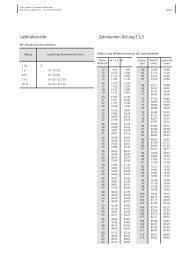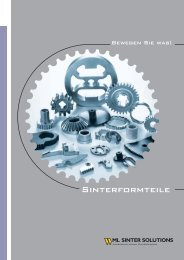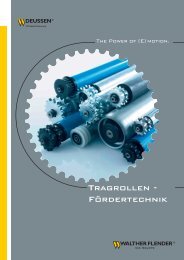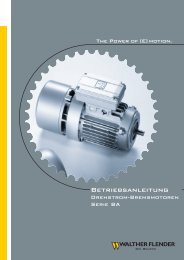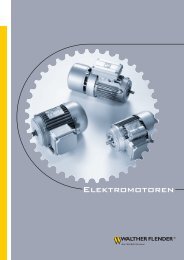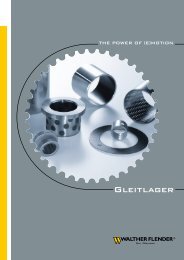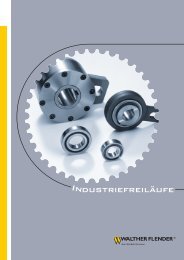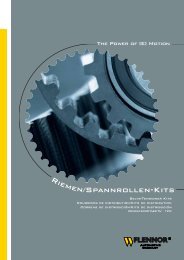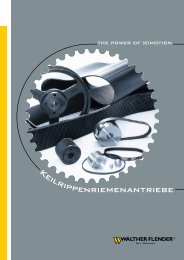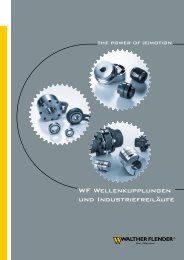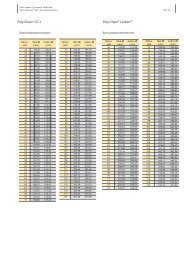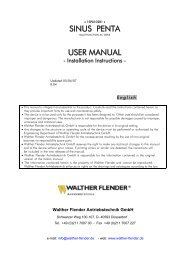PolyChain® GT Timing Belts - Walther Flender
PolyChain® GT Timing Belts - Walther Flender
PolyChain® GT Timing Belts - Walther Flender
Create successful ePaper yourself
Turn your PDF publications into a flip-book with our unique Google optimized e-Paper software.
<strong>Walther</strong> <strong>Flender</strong> Gruppe<br />
PolyChain ® <strong>GT</strong> <strong>Timing</strong> <strong>Belts</strong> PAGE 23<br />
Calculation & formulas<br />
Calculation<br />
General<br />
The basis for determining the timing belt dimensions is a calculation<br />
method that takes the following influences into account:<br />
* Power<br />
* Torques<br />
* Speed<br />
* Duty cycle of the drive system<br />
* Operating characteristics<br />
* Number of meshing teeth<br />
* Transmission ratio<br />
* Centre distance of axes<br />
All data concerning the transmitted torque, the speed and the<br />
length of a <strong>PolyChain®</strong> timing belt relates to the pitch line, which<br />
is assumed to be centre of the tensile member. The pitch line is<br />
precisely defined and is identical to the pitch diameter on the timing<br />
belt pulley. Half the difference in diameter between the pitch<br />
diameter and outer diameter is equal to the size of the belt tooth<br />
root to the centre of the tensile body.<br />
Project data sheet<br />
During the design and the later dimensioning of a drive system,<br />
you should remember that optimum use of the transmission<br />
capacity, long service life and high efficiency are possible only if<br />
the actual operating conditions are known, so that critical conditions<br />
can already be taken into account during the design stage.<br />
The project data sheet on page 44 is provided to help you with<br />
this task.<br />
Preliminary selection<br />
Use the diagram on page 5 to make a preliminary selection of the<br />
suitable belt pitch.<br />
Belt width<br />
Taking into account the inherent load of the timing belt, it is<br />
always a good idea to select a belt width that is smaller than the<br />
diameter of the smallest timing belt pulley. A wider timing belt, if<br />
mounted incorrectly, is more likely to cause varying edge tensions,<br />
which can prevent optimum running of the belt. In borderline<br />
cases, it is often better to select a larger pitch instead of a wider<br />
belt. If this is not possible, we recommend a belt pitch in 2 parallel<br />
running belt segments (of the same length), to reduce the<br />
transverse rigidity of the belt in combination with the small pulley<br />
diameters.<br />
Pulley diameter<br />
Use pulleys with the largest diameters possible! This makes optimal<br />
use of the power output range of the belt at high peripheral<br />
speeds. Pulleys with larger diameters have less bending stress and<br />
the belt does not have to be as wide.<br />
Safety factors<br />
The table on page 25 shows load factors that include the drive<br />
characteristics of various machine types as an increased safety<br />
factor.<br />
In addition to these safety factors, it can be extremely important<br />
to include starting and stopping processes together with the corresponding<br />
mass effects of the respective drive system as a design<br />
criterion for the safety considerations. Especially during stopping<br />
or locking processes, mass effect can cause inertia forces that are<br />
far above the maximum permissible tangential loads of the belts<br />
listed in the power output tables (pages 17 and 20).<br />
The use of suitable regulators (e.g. a soft start ramp controller for<br />
starting and stopping) or the use of suitable overload protection<br />
can greatly reduce the mass effect to optimize fail-safe operation.<br />
Abbreviations<br />
a<br />
a<br />
A<br />
b<br />
b R<br />
B<br />
B W<br />
C spez<br />
d B<br />
d a<br />
d w<br />
d wk<br />
d wg<br />
e<br />
F a<br />
F b<br />
F B<br />
F H<br />
F P<br />
F R<br />
F t<br />
F U<br />
F V<br />
F zul<br />
g<br />
h S<br />
h t<br />
i<br />
l w<br />
l t<br />
M<br />
m<br />
m L<br />
m R<br />
m ges<br />
m Z<br />
m Z, red<br />
n<br />
n MOT<br />
P<br />
P B<br />
P N<br />
S Bruch<br />
S G<br />
S 1<br />
S 2<br />
S 3<br />
S 4<br />
S 5<br />
S 6<br />
S 7<br />
t<br />
v<br />
z<br />
z e<br />
z g<br />
z k<br />
Temperature expansion coefficient<br />
Acceleration<br />
Centre distance of axes<br />
Braking deceleration<br />
Belt width<br />
Pulley width<br />
Flexural fatigue<br />
Specific spring constant<br />
Bore diameter<br />
Outer diameter<br />
Pitch diameter<br />
Pitch diameter of small pulley<br />
Pitch diameter of large pulley<br />
Stretching<br />
Acceleration force<br />
Braking force<br />
Driving force, calculated<br />
Lifting force<br />
Test load for belt tension<br />
Friction force<br />
Span tension<br />
Tangential load<br />
Initial tension<br />
Maximum permissible tangential load<br />
Acceleration of gravity<br />
Belt thickness<br />
Tooth height<br />
Transmission ratio<br />
Pitch length<br />
Taut side<br />
Torque<br />
Mass<br />
Mass of load<br />
Mass of belt<br />
Total weight<br />
Mass of timing belt pulley<br />
Reduced mass of timing belt pulley<br />
Speed<br />
Motor speed<br />
Power output<br />
Calculated power output<br />
Rated power output<br />
Security against fracture<br />
Total application factor<br />
Load factor<br />
Tooth mesh factor<br />
Transmission allowance<br />
Bending factor<br />
Special application factor<br />
Belt length factor<br />
Belt width factor<br />
Pitch<br />
Speed<br />
Number of belt pulleys<br />
Number of meshing teeth<br />
Number of teeth, large pulley<br />
Number of teeth, small pulley<br />
1/K<br />
m/s 2<br />
mm<br />
m/s 2<br />
mm<br />
mm<br />
1/s<br />
N<br />
mm<br />
mm<br />
mm<br />
mm<br />
mm<br />
%<br />
N<br />
N<br />
N<br />
N<br />
N<br />
N<br />
N<br />
N<br />
N<br />
N<br />
m/s 2<br />
mm<br />
mm<br />
mm<br />
mm<br />
Nm<br />
kg<br />
kg<br />
kg<br />
kg<br />
kg<br />
kg<br />
l/min<br />
l/min<br />
kW<br />
kW<br />
kW<br />
m/s<br />
(The formula collection applies to all timing belt catalogs;<br />
therefore, it is possible that not all abbreviations occur in<br />
this catalog).



